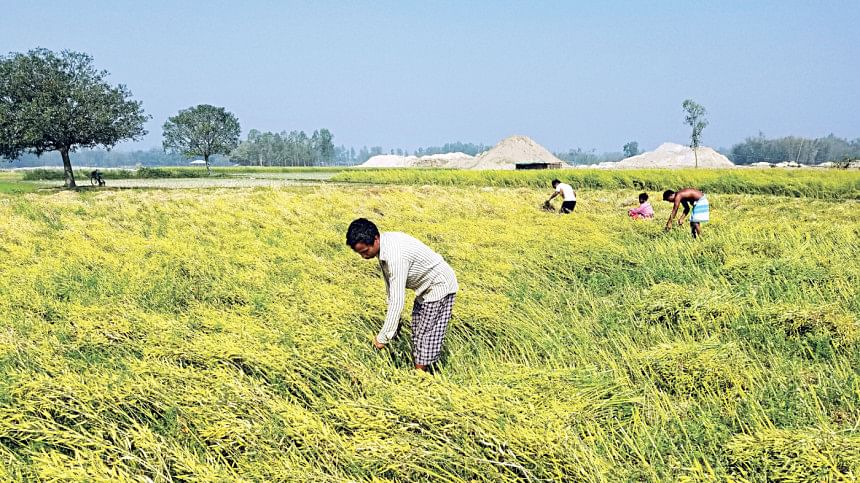Growers rejoice higher yield, rising consumption of mustard oil

Mustard growers in Thakurgaon and Panchagarh districts are elated thanks to the higher output in the ongoing harvesting season as well as the increased price of the cooking oil owing to rising consumption amid the volatile soybean oil market.
Using the land between the gap of Aman and Boro paddy season, farmers take home additional incomes by cultivating the improved varieties of the crop.
The higher yield and extra profits in a short duration have led to an expansion of the crop's cultivation area in the northern districts, helped by suitable soil and favourable climatic condition in the region, officials of the Department of Agricultural Extension (DAE) said.
Besides, the increasing consumption of the oilseed has kept its price at a higher level as consumers consider the cooking oil good for health in comparison to other edible oils.
Each maund, or 40 kilogrammes, of mustard is being sold at Tk 3,000 to Tk 3,200 at the farmers' level in the ongoing harvesting season, up from Tk 2,000 and Tk 2,200 during the same time last year.
Usually, the price doesn't see such a spike during the harvesting season. But consumers are increasingly switching to mustard oil after the soybean oil segment became volatile in recent times for the rise in prices globally and locally.
About 13,374 hectares of land have been brought under mustard cultivation in Thakurgaon against the target of 12,635 hectares. The production target has been set at 19,711 tonnes.
Last season, the growers produced 19,698 tonnes of mustard by cultivating them on 12,635 hectares.
In Panchagarh, farmers have sown the oilseed on 4,145 hectares against the official goal of 3,050 hectares. The production target is 4,484 tonnes.
Last season, 4,409 tonnes of oilseed were produced in the district on 3,000 hectares of land.
Farmers and agriculture officials expect the production target to surpass after seeing the yield at various places in the two districts.
Rafiqul Islam, a farmer in Yakubpur village of Thakurgaon sadar upazila, has grown mustard on 50 decimals of land this season after collecting the Aman crop.
He grew 10 maunds of oilseed last year and sold them in the local market for a total of Tk 23,000. The production cost was Tk 4,500.
This year, he received 11 maunds of the produce and has already sold half of the output at Tk 3,000 per maund.
The 45-year-old plans to sell the rest after the harvesting period comes to an end as the price might go up if demand retains the upward trend and the current volatility in the edible oil market persists.
Anikul Barman, a farmer in Moidandighi village in Boda upazila of Panchagarh, has cultivated mustard on 33 decimals of land.
Last year, he got eight maunds of oilseed spending Tk 3,000. The crop fetched him a total of Tk 19,200.
As the 55-year-old made a profit of Tk 16,200 from mustard cultivation, he was able to cultivate Boro on the same land without borrowing any money from anybody.
"Mustard growing requires simple effort and light irrigation twice. This is less costly compared to the cultivation of other crops," he said.
The mid-October to mid-November is the suitable time for mustard cultivation and it takes 70 to 75 days to grow the improved varieties of the crop developed by the Bangladesh Agricultural Research Institute during the gap between aman and boro paddies, according to Abu Hossain, a deputy director of the DAE.
Nazmun Nur, a homemaker in Hazipara of Thakurgaon municipality, was habituated to use soybean oil for cooking purposes earlier. As the edible oil price has shot up several times in the last six months, she has shifted to mustard oil.
"Mustard oil is good for health as the elders often say. The cooking can be done with a lesser quantity of mustard oil than soybean."
Anjuman Ara Mukta, a housewife in Kalibari in the same town, echoed Nazmun Nur.
She added: "As the price of soybean oil has gone up abnormally, we prefer mustard oil to soybean."
Mohammad Raju, manager of a grocery shop in the Thakurgaon town, says the consumption of mustard oil has increased fast.
His shop used to sell a 25-kg container of the oil in a month a few months ago whereas it is selling five times more currently.
Mohammad Lebu, a seed trader in Atwary bazar in Panchagarh, says he has been involved in the trade for about 12 years but he has not seen such a price of mustard during the harvesting period.
Last year, Arani Mustard Oil Mill in Thakurgaon produced 80,602 kgs oil by extracting 210 tonnes of seed, up from 69,677 kgs oil from 190 tonnes.
"Even if we produce more it will be consumed as well since there is demand in the market," said Rezwanul Haque Reza, manager of the mill.
In Bangladesh, 2.5 lakh to 3 lakh tonnes of mustard seeds are imported every year, and about 1 lakh tonnes of oilseed is produced in the country.
Currently, the annual demand for mustard oil stands at 1.5 lakh tonnes.

 For all latest news, follow The Daily Star's Google News channel.
For all latest news, follow The Daily Star's Google News channel. 



Comments